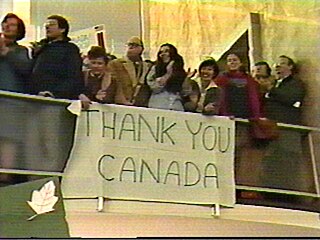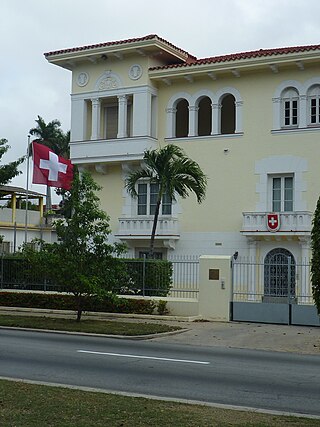
A diplomatic mission or foreign mission is a group of people from a state or organization present in another state to represent the sending state or organization officially in the receiving or host state. In practice, the phrase usually denotes an embassy or high commission, which is the main office of a country's diplomatic representatives to another country; it is usually, but not necessarily, based in the receiving state's capital city. Consulates, on the other hand, are smaller diplomatic missions that are normally located in major cities of the receiving state. As well as being a diplomatic mission to the country in which it is situated, an embassy may also be a nonresident permanent mission to one or more other countries.

Ambassadors of the United States are persons nominated by the president to serve as the country's diplomatic representatives to foreign nations, international organizations, and as ambassadors-at-large. Under Article II, Section 2 of the U.S. Constitution, their appointment must be confirmed by the United States Senate; while an ambassador may be appointed during a recess, they can serve only until the end of the next session of Congress, unless subsequently confirmed.

The Iran hostage crisis was a diplomatic standoff between Iran and the United States. Fifty-three American diplomats and citizens were held hostage after a group of militarized Iranian college students belonging to the Muslim Student Followers of the Imam's Line, who supported the Iranian Revolution, including Hossein Dehghan, Mohammad Ali Jafari and Mohammad Bagheri, took over the U.S. Embassy in Tehran and took them as hostages. The hostages were held for 444 days, from November 4, 1979 to their release on January 20, 1981. The crisis is considered a pivotal episode in the history of Iran–United States relations.

The Interests Section of the Islamic Republic of Iran in the United States is a part of the Pakistani Embassy in Washington, D.C., and is the de facto consular representation of the Islamic Republic of Iran in the United States.

United States of America v. Islamic Republic of Iran [1980] ICJ 1 is a public international law case brought to the International Court of Justice by the United States of America against Iran in response to the Iran hostage crisis, where United States diplomatic offices and personnel were seized by militant revolutionaries.

The "Canadian Caper" was the joint covert rescue by the Canadian government and the CIA of six American diplomats who had evaded capture during the seizure of the United States embassy in Tehran, Iran, on November 4, 1979, after the Iranian Revolution, when Islamist students took most of the American embassy personnel hostage, demanding the return of the US-backed Shah for trial.
The Muslim Student Followers of the Imam's Line, also called the Muslim Students of the Imam Khomeini Line, was an Iranian student group that occupied the U.S. embassy in Tehran on 4 November 1979. The students were supporters of the Islamic Revolution who occupied the embassy to show their support for Ayatollah Khomeini and their outrage that the ex-Shah of Iran was admitted to the United States for cancer treatment, instead of being returned to Iran for trial and execution. The occupation triggered the Iran hostage crisis where 52 American diplomats and citizens were held hostage for 444 days.

A protecting power is a country that represents another sovereign state in a country where it lacks its own diplomatic representation. It is common for protecting powers to be appointed when two countries break off diplomatic relations with each other. The protecting power is responsible for looking after the protected power's diplomatic property and citizens in the hosting state. If diplomatic relations were broken by the outbreak of war, the protecting power will also inquire into the welfare of prisoners of war and look after the interests of civilians in enemy-occupied territory.
On January 11, 2007, the United States military raided the Iranian Liaison Office in Erbil, Kurdistan Region, Iraq, ostensibly to detain two senior Iranian officials, but captured five mid-level diplomats instead. The U.S. government's position is that the office was used by the Iranian Islamic Revolutionary Guard Corps (IRGC) as a local headquarters. However, both Iranian and Kurdish officials state that it was a diplomatic mission in the city of Erbil.

Iran–Switzerland relations are foreign relations between the Islamic Republic of Iran and the Swiss Confederation.

Canada and Iran have had no formal diplomatic relations since 2012. In the absence of diplomatic representation, Italy acts as the protecting power for Canada in Iran and Switzerland acts as Iran's protecting power in Canada.

The Former Embassy of Iran in Washington, D.C. was the Imperial State of Iran's diplomatic mission to the United States. Direct bilateral Iran–United States relations between the two governments were severed following the Iranian Revolution in 1979, and the subsequent seizure of hostages at the U.S. Embassy in Tehran, Iran.

Hamid Aboutalebi is a former Iranian diplomat and ambassador. Aboutalebi was previously ambassador of Iran to Australia, the European Union, Belgium, Italy, and a political director general to Iran's Ministry of Foreign Affairs. He was part of Iran's UN delegation in New York City in the 1990s.

Public Law 113-110 is a law that "ban(s) Iran's new United Nations ambassador, who has ties to a terrorist group, from entering the United States." Iran's proposed ambassador, Hamid Aboutalebi, is controversial due to his involvement in the Iran hostage crisis, in which a number of American diplomats from the US embassy in Tehran were held captive from 1979 until 1981. Aboutalebi said he did not participate in the takeover of the US embassy, but was brought in to translate and negotiate following the occupation. President Barack Obama told Iran that Aboutalebis selection was not "viable" and Congress reacted by passing this law to ban his presence in the United States.
General Mohsen Vezvaei was an Iranian military officer in the Islamic Revolutionary Guard Corps (IRGC) and military figure in the Iran-Iraq War. He was also involved in street protests against the Shah of Iran, and later participated in the 1979 Iranian hostage crisis.

The former Consulate-General of the United States, Tabriz was a diplomatic and political venue in Tabriz that operated under the auspices of the US Embassy in Tehran. This consulate was opened in 1906 and was active until the capture of the US Embassy in Tehran and the severance of Iran-US relations.

The United States Cultural Diplomacy in Iran refers to the use of soft power of cultural diplomacy by the US government towards Iran in order to achieve its own interests.


















